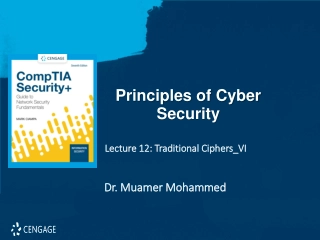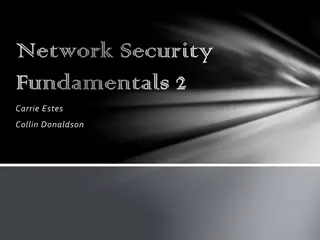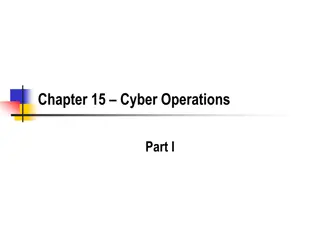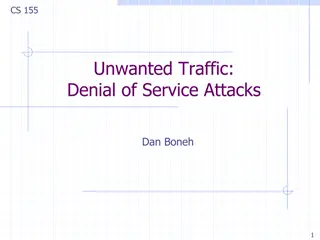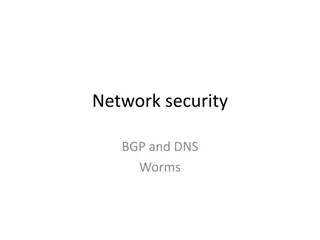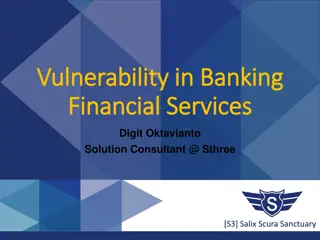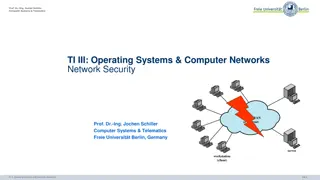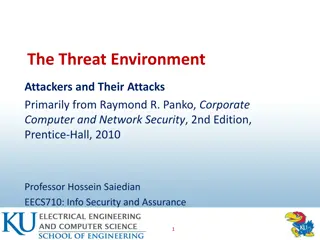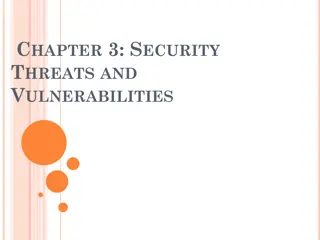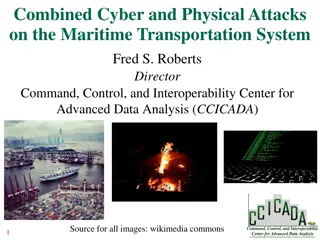Understanding Man-in-the-Middle Attacks and Network Security Threats
Explore the risks associated with Man-in-the-Middle attacks including password sniffing and cracking. Learn about ethical hacking, ARP poisoning techniques, encryption methods, and the importance of information security. Discover the legality of hacking under certain conditions and gain insights into securing data through cryptography techniques.
Download Presentation

Please find below an Image/Link to download the presentation.
The content on the website is provided AS IS for your information and personal use only. It may not be sold, licensed, or shared on other websites without obtaining consent from the author. Download presentation by click this link. If you encounter any issues during the download, it is possible that the publisher has removed the file from their server.
E N D
Presentation Transcript
Man in the Middle Attack: Password Sniffing and Cracking By Collin Donaldson
November 7this Information Assurance Day. There will be guest speakers giving presentations all day. It is recommended you attend as many as possible. Aside from learning new material and possibly receiving bonus points for your classes, there are always networking possibilities. IA Day Reminder!
Hacking is only legal under the following circumstances: 1. You hack (penetration test) a device/network you own. 2. You gain explicit, documented permission from an individual, assumedly a friend. 3. You acquire an Ethical Hacker Certification and hack for a public or private sector organization with explicit permission to do so. This is the safest of the three methods. Hacking is illegal in all other circumstances. Hackers can be charged with fines, misdemeanors, and/or felonies depending on severity and accounts of hacks. For these reasons I will not be demonstrating any live hacking attempts in the wild. For more information http://definitions.uslegal.com/c/com puter-hacking/ Disclaimer!
Definition: When two systems are communicating and a hacker intercepts their communications via active eavesdropping. Hacker must be able to control the data transfer without the user s knowledge. Similar to using XSS attacks to intercept cookies with user data in them. We will intercept a network password as it travels via data packet from access point to access point. Man in the Middle Attack (MITMA)
ARP Poisoning ARP Poisoning is a technique whereby an attacker sends fake ("spoofed") Address Resolution Protocol (ARP) messages onto a Local Area Network. Generally, the aim is to associate the attacker's MAC address with the IP address of another host (such as the default gateway), causing any traffic meant for that IP address to be sent to the attacker instead.
Since ancient times people have sought to secure information , from the Caesar Cipher to AES 256 bit data encryption. Main Methods: Encryption: Converting plain text into text that can be read with a cipher, often using underlying mathematics such as derivatives. Obfuscation: Making a message deliberately confusing , ambiguous, cryptic, etc. . (i.e. Hiding cryptographic keys in a file full of false keys and junk files) Stenography: Hiding something in plain site (i.e. Hide a message as a comment deep inside a source file). Cryptography: The Core of Passwords
Definition: A password sniffer is a software application that scans and records passwords that are used or broadcasted on a computer or network interface. It listens to all incoming and outgoing network traffic and records any instance of a data packet that contains a password. Password Sniffing We will use a password sniffer to exploit network vulnerabilities similarly to how we used JavaScript and SQL to test for website and database vulnerabilities.
Definition: Program that recovers passwords from data that have been stored in or transmitted by a computer system. Password Cracking Can be used ethically (recover lost password, penetration testing, etc.) or maliciously (steal passwords, lock users out of their own accounts, etc.).
Dictionary: Uses a dictionary of terms to try and guess the password. Pro: Quickly finds weak passwords and can be used to aid in finding complicated ones faster. Cons: Limited by dictionary used and basic obfuscation can defeat it. Cryptoanalysis: Uses cryptographic algorithms and rainbow tables to try and determine password. Pro: Relatively fast and relatively high success rate Con: Dependent on underlying algorithms, not guaranteed to work. Brute Force: Systematically checks all possible values until the correct one is found. Pro: Virtually guaranteed to work Con: SLOW, vulnerable to obfuscation Types of Password Cracking
We will use a password sniffing and cracking suite called Cain and Abel for this workshop. Cain is the sniffer, Able is the cracker. It is a professional tool and it is safe to download, I guarantee it! Download it from the following sources. Original Source: http://www.oxid.it/cain.html Easier to download source: http://www.majorgeeks.com/files/ details/cain_and_abel.html NOTE: You may have to temporarily disable your firewall and/or antivirus to run Cain and Abel. Cain and Abel
http://www.youtube.com/watch?v =RyQL9AdxHqY The one we will watch Skip to 1:06 Overview and Password Sniffing/Cracking These two cover ARP poisoning and Password Cracking/Sniffing two different ways http://www.youtube.com/watch?v =5Ux6o0IKNX4 Skip to 2:37 Video Tutorial http://www.youtube.com/watch?v =OtxEixSWL8E Skip to 0:33
1. Manually change your guest account password into something that would be found in the default dictionary i.e. password 2. Run a dictionary attack against your guest account 3. Complicate your password password123 . 4. Run a dictionary search against it, if the password isn t returned run a brute force against it. 5. Further complicate your password p@$sword123 6. Run a cryptanalysis attack against it. Steps to Try




